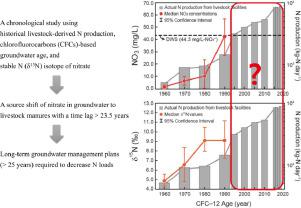Water Research ( IF 12.8 ) Pub Date : 2021-01-06 , DOI: 10.1016/j.watres.2021.116814 Seok Hee Kim , Ho-Rim Kim , Soonyoung Yu , Hyun-Ji Kang , Ik-Hyun Hyun , Young-Cheol Song , Hyunkoo Kim , Seong-Taek Yun

|
Time lags between anthropogenic nitrogen inputs and their impacts to nitrate levels cause a misunderstanding for sources and subsequently misguide the groundwater management.We investigated the hydrochemical data of groundwater samples (n = 172 from 49 wells) with chlorofluorocarbons (CFCs)-based groundwater age dating and stable N (δ15N) and O isotopes (δ18O) of nitrate to assess the legacy effect of livestock farming to groundwater in an agricultural area where intensive livestock farming started in the 1970s and illegal dumping of manure wastewater in a lava cave was revealed in 2015. Approximately 90% of the groundwater samples had nitrate concentrations exceeding the natural threshold (5.5 mg/L NO3−) for nitrate contamination and 34% exceeded the World Health Organization's guideline for drinking water quality (44.3 mg/L), indicating severe nitrate contamination. The δ15NNO3 values (5.5 to 24.3‰) in groundwater exceeding the threshold of nitrate showed that livestock manure was a major nitrate source, while ammonium fertilizer also seemed influential given the δ15NNO3 values in the overlapping fields of N sources. Factor analysis of hydrochemical data also supported nitrate contamination by manure as well as by plant farming in the study area. Based on the spatial distribution of nitrate levels and δ15NNO3, livestock farming affected nitrate contamination by illegal manure dumping in the leakage cave. According to a Bayesian mixing model, the contribution of manure wastewater was 33.5 to 81.8% as of 2015–2018, with the rest from fertilizers. Meanwhile, the groundwater ages showed negative correlations with both nitrate levels (r = –0.90) and δ15NNO3 values (r = –0.74) on a log scale, consistent with the increasing N release from livestock farming since the 1960s. In particular, the median value of δ15NNO3 rapidly increased to 9.2‰ in groundwater recharged between the late 1970s and early 1990s when N production exponentially increased, implying a significant effect of livestock farming after the 1980s. Groundwater quality is expected to deteriorate over the next several decades based on the groundwater ages (> 23.5 years), the increased N production from livestock farming, and the legacy effect of N. Long-term groundwater management plans (> 25 years) are required to decrease N loads in the study area, because it takes time for management practices to take effect. The study results are a good reference for groundwater management in regions with a source shift to livestock farming under intensive livestock production systems. Moreover, the chronological study using historical N production, groundwater age data, and dual nitrate isotopes can be applied to other regions with multiple N sources and their shifting for identifying sources and estimating time lags.
中文翻译:

由于韩国济州岛进行密集的畜牧业,导致地下水中硝酸盐源的转移:重点在于对水管理的遗留影响
人为氮输入及其对硝酸盐水平的影响之间存在时间差,导致对来源的误解,进而误导了地下水管理。我们 使用基于氯氟烃(CFC)的地下水年龄测年研究了地下水样品(n = 172的49口井)的水化学数据和稳定的N(δ 15 N)和氧同位素(δ 18 O)的硝酸,以评估牲畜在密集牲畜在20世纪70年代农业的开始和非法在熔岩洞穴粪肥废水倾倒农业区农业到地下水遗留效应的揭示在地下水样品具有硝酸浓度超过天然的阈值(5.5毫克/升NO 2015大约90%3 -)中的硝酸盐污染,其中34%超过了世界卫生组织的饮用水质量准则(44.3 mg / L),表明硝酸盐污染严重。的δ 15 Ñ NO3值(5.5至24.3‰)在地下水超过硝酸盐的阈值表明,牲畜粪便是一个重大的硝酸盐源,而铵肥料给出的δ似乎也有影响15 Ñ NO3值的N个源的重叠视场。水化学数据的因子分析还支持了研究区域粪便和植物种植对硝酸盐的污染。基于硝酸盐水平的空间分布和δ 15 Ñ NO3,畜牧业通过将非法粪便倾倒在泄漏洞中而影响了硝酸盐污染。根据贝叶斯混合模型,截至2015–2018年,粪便废水的贡献率为33.5%至81.8%,其余部分来自化肥。同时,地下水年龄表明既硝酸盐含量(负相关[R = -0.90)和δ 15个ñ NO3值([R = -0.74)对数标度,与家畜的N个版本增加自1960年以来养殖一致。具体地讲,δ的中值15 Ñ NO31970年代末至1990年代初,当氮的产量成倍增加时,地下水的补给迅速增加到9.2‰,这意味着1980年代后畜牧业产生了显着影响。基于地下水年龄(> 23.5年),畜牧业氮产量增加以及氮的遗留影响,预计未来几十年地下水质量将恶化。需要长期的地下水管理计划(> 25年)减少研究区域中的N负荷,因为管理实践需要时间才能生效。该研究结果为在集约化畜牧生产系统下水源转向畜牧业的地区的地下水管理提供了很好的参考。此外,使用历史氮产量,地下水年龄数据进行的年代学研究,



























 京公网安备 11010802027423号
京公网安备 11010802027423号